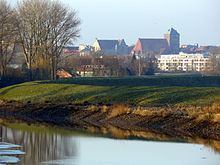River mouth Stadersand0 m (0 ft) Length 29 km | ||
 | ||
Main source In the Hohes Moor near Mulsum9 m (30 ft) Tributaries Left:Grenzgraben, Kattenbeck, Harschenflether WetternRight:Kühlhornsbach, Beverbeck, Fredenbecker Mühlenbach, Westernbeck, Steinbeck, Heidbeck, Hollerner Moorwettern | ||
The Schwinge is a 27.8 kilometres (17.3 mi), left-sided river of the Elbe in Lower Saxony, Germany. It is rising in the Hohes Moor near Mulsum on the Stade Geest in the bifurcation area with the Oste. From there it flows in a largely natural, more than 20-kilometre-long (12 mi) upper reach towards Stade. Because of its very natural river scenery and its biodiversity the floodplains of the upper reach and the meadows near Stade are protected for landscape conservation.
Map of Schwinge, Germany
In Stade the ca. 1000-year-old Hansa port ("Hansehafen") lies at the Schwinge. Here the upper reach is isolated from tides by a sluice called "Salztorschleuse" since 1792; the lower reach of the Schwinge, which flows into the lower Elbe north-eastern of Stade at Stadersand, begins. Because of the deepening of the Elbe the average tidal hub of the lower reach rose to 3.3 metres (11 ft), because of the backlog when the sluice gates are closed the fluctuations of the upper reach only amounts to a few decimeters. Despite the embankment the banks of the lower reach are lined with exceptional rare fresh water mudflats.
The Schwinge is a 4.6-kilometre-long (2.9 mi) federal waterway from the Elbe to the "Salztorschleuse". Since the completion of the Schwingesperrwerk, a flood barrier near the mouth of the river, in 1971 all places at the Schwinge are protected better against storm surges. The 16-metre-wide (52 ft) gap is closed with two gates.
From the Late Middle Ages until the 1950s the Schwinge was used for the transport of goods with smack-like ships called "Ewer". During dredging of the Schwinge and the "Hansehafen" countless historic artefacts were found, including famous Inschriftenschwerter with the inscription Ulfbehrt from the 8th to 12th century. Today, however, the leisure and sports boat traffic dominates the shipping on the lower reach, the upper reach beyond Stade isn't navigable.
